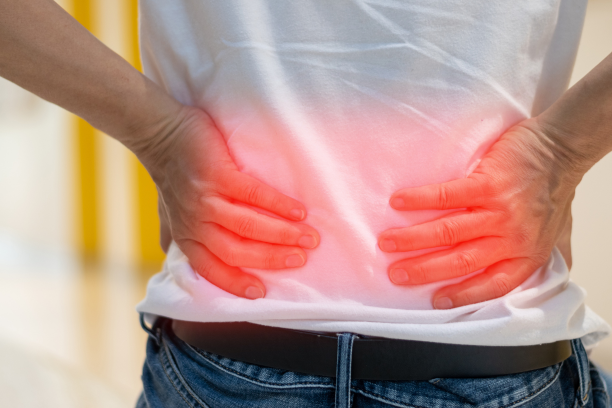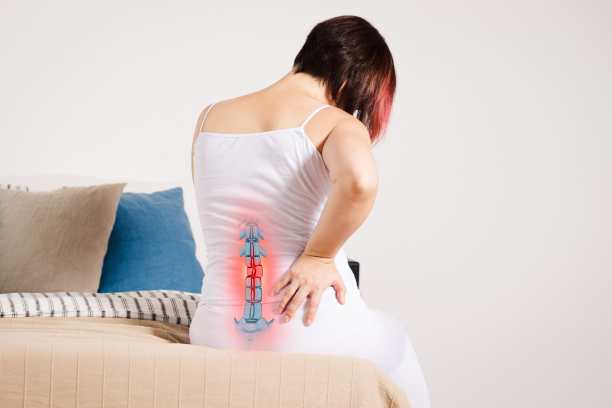Slip disc, medically known as a herniated or prolapsed intervertebral disc, is a common spinal condition that affects many individuals, including gym-goers and fitness enthusiasts. While engaging in strength training, high-intensity workouts, or flexibility routines, incorrect technique, sudden load increases or inadequate recovery can precipitate disc herniation. Recognising early warning signs is vital to prevent progression, ensure prompt management and safeguard long-term spinal health.
Understanding Slip Disc
Anatomy of the Spine
The human spine consists of vertebrae separated by intervertebral discs. Each disc has a tough outer ring (annulus fibrosus) and a gel-like core (nucleus pulposus). Discs function as shock absorbers, facilitating flexibility and distributing mechanical loads.
Pathophysiology of Disc Herniation
A slip disc occurs when the annulus fibrosus weakens or tears, allowing the nucleus pulposus to protrude. This displacement can compress adjacent nerve roots or the spinal cord, leading to pain, numbness or neurological deficits.
Prevalence Among Fitness Enthusiasts
Risk Concentrations
While slip disc prevalence in the general adult population is estimated at 1–3%, gym-goers exhibit a higher incidence due to repetitive spinal loading, heavy lifting and rapid movement patterns. Research indicates weightlifters can have a two-fold increase in herniation risk compared to non-athletes.
Contributing Factors
Improper lifting technique, sudden increases in training load, muscle imbalances and inadequate core stability all contribute to disc injury. Training without progressive overload principles or ignoring recovery further heightens vulnerability.
Common Symptoms of Slip Disc
Localised Back Pain
Pain at the level of herniation is often the earliest symptom. It may be dull or sharp, exacerbated by movements such as bending, twisting or lifting. Gym activities involving spinal flexion under load (e.g. deadlifts) typically aggravate discomfort.
Radicular Pain (“Sciatica”)
If a herniated disc compresses the sciatic nerve roots (L4–S1), pain radiates down the buttock, thigh, calf or foot. This shooting or burning pain intensifies with walking, coughing or sneezing.
Sensory Changes
Numbness, tingling or “pins and needles” may occur in dermatomal distributions. For lumbar herniations, sensations often affect the lateral leg, dorsum of the foot or sole.
Motor Weakness
Compression of motor nerve fibres can lead to weakness in specific muscle groups. Examples include diminished ankle dorsiflexion (“foot drop”) or reduced quadriceps strength, impairing activities like squatting or step-ups.
Reflex Alterations
A herniation can disrupt deep tendon reflexes. Diminished patellar or Achilles reflexes signal nerve root involvement and warrant immediate assessment.
Aggravating and Alleviating Factors
Pain may worsen with sitting, bending forward or lifting. Conversely, standing, walking or lying on a firm surface often provides relief. Altered posture, such as leaning away from the painful side, is common.
Slip Disc in Gym Settings
High-Risk Exercises
- Deadlifts and Bent-Over Rows: Excessive lumbar flexion under heavy load increases disc pressure by up to 275%
- Squats (High Load): Improper spinal alignment during deep squat phases stresses lumbar discs
- Sit-Ups and Russian Twists: Repetitive flexion-rotation movements can weaken the annulus fibrosus over time
Training Errors
Improper form is a primary cause. Rounded back during lifts, jerky initiation of movement and asymmetrical loading place uneven stress on spinal structures.
Overtraining and Insufficient Recovery
Inadequate rest intervals, missing deload weeks and failure to address muscular imbalances lead to cumulative spinal microtrauma, ultimately precipitating disc herniation.
Prevention Strategies
Technique and Biomechanics
- Maintain a neutral spine during lifts
- Engage the core and gluteal muscles before initiating movement
- Use hip hinge mechanics rather than lumbar flexion for bending movements
Programme Design
- Include progressive overload with gradual weight increments (no more than 10% per week)
- Incorporate mobility and stability drills for the hips, thoracic spine and core
- Balance posterior chain with anterior musculature to ensure even load distribution
Recovery and Load Management
- Schedule rest days and deload weeks
- Implement active recovery techniques such as foam rolling or yoga
- Monitor training loads using a workout log or digital tracking apps
Supportive Equipment
- Use weightlifting belts judiciously to maintain intra-abdominal pressure during maximal lifts
- Consider lumbar support straps for those with a history of mild disc degeneration
When to Seek Medical Attention
Red Flags
Immediate medical evaluation is essential if any of the following occur:
- Severe or worsening neurological deficits: Sudden weakness or inability to move a limb
- Bladder or bowel dysfunction: Signs of cauda equina syndrome
- Unrelenting pain unresponsive to conservative measures
Initial Assessment
General practitioners or sports medicine specialists perform neurological examinations, assessing motor strength, reflexes and sensory function. Diagnostic imaging (MRI) confirms disc herniation and aids surgical planning if required.
Conservative Management
Most slip disc cases respond to non-surgical approaches:
- Physiotherapy: Targeted exercises to restore mobility, strengthen core stabilisers and correct movement patterns
- Pharmacotherapy: NSAIDs, muscle relaxants or neuropathic pain agents
- Epidural Steroid Injections: For refractory radicular pain
Surgical Considerations
Surgery, such as micro-discectomy or laminectomy, is reserved for those with intractable pain, progressive neurological deficits or cauda equina syndrome. Post-operative rehabilitation emphasises a gradual return to training under professional supervision.
Rehabilitation and Return to Fitness
Phased Recovery Protocol
- Acute Phase (0–2 weeks)
- Relative rest, pain management and gentle mobility exercises
- Subacute Phase (2–6 weeks)
- Gradual introduction of isometric core activations and low-impact aerobic activity
- Strengthening Phase (6–12 weeks)
- Progressive resistance exercises focusing on core, glutes and posterior chain
- Functional Phase (3+ months)
- Sport-specific drills, plyometrics and full return to gym training under technique supervision
Monitoring and Re-Assessment
Regular follow-up with a physiotherapist or sports physician ensures symptom resolution and technique correction. Functional movement screens and strength tests gauge readiness for advanced training.
Long-Term Maintenance
Continued emphasis on mobility, balanced strength training and periodic deload cycles helps prevent recurrence. Incorporating complementary practices such as Pilates or anti-gravity yoga further supports spinal health.
Conclusion
Slip disc is a significant concern for gym-goers and fitness enthusiasts, often resulting from biomechanical errors, overtraining and insufficient recovery. Early recognition of symptoms such as localised back pain, radicular leg pain, sensory changes and motor weakness can prompt timely intervention. Prevention through proper technique, structured training programmes and recovery strategies is crucial. Conservative management remains effective for most individuals, while surgical options are reserved for severe or progressive cases. A phased rehabilitation approach, coupled with long-term maintenance plans, ensures sustained spinal health and a safe return to training.
References
- Mayo Clinic, Herniated Disk - Symptoms and Causes, https://www.mayoclinic.org/diseases-conditions/herniated-disk/symptoms-causes/syc-20354095
- NHS, Slipped Disc, https://www.nhs.uk/conditions/slipped-disc/
- Healthline, Slipped (Herniated) Disc: Symptoms, Causes, and Effects, https://www.healthline.com/health/herniated-disk
- Spine-Health, Lumbar Herniated Disc Symptoms, https://www.spine-health.com/conditions/herniated-disc/lumbar-herniated-disc-symptoms
- Cleveland Clinic, Herniated Disk (Slipped or Bulging Disk), https://my.clevelandclinic.org/health/diseases/12768-herniated-disk










